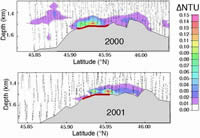| |
| |

This figure compares hydrothermal plumes
overlying the 1998 eruption zone as mapped in July 2000 and July 2001.
The heavy red line marks the approximate extent of the main 1998 lava
flow. "NTU" is a measure of the relative concentration of
particles
suspended in the plume; higher values indicate a higher concentration
of
hydrothermal material. The figure shows that relative to 2000, the
plumes
this year are less extensive, of lower concentration, and have a lower
height of rise above the seafloor. All these signs point to a lessening
of hydrothermal activity.
|
|
R/V Wecoma - CTD Cruise
Science News
Science
Report - Tuesday, July 24, 2001
Position - 45 54.659' N /130 12.053' W
Chief Scientist Ed Baker
We
are finding some time now to think about the data we're collecting and
compare it to previous year's results. The accompanying figure shows results
from two CTD tow-yos along the trend of the 1998 volcanic eruption on
the east side of the caldera. Compared to last summer, this year's tow
shows that hydrothermal plumes extend over less of the eruption site,
have weaker concentrations of hydrothermal particles, and a lower height
of rise above the seafloor. We interpret these observations to indicate
that there are fewer active sites of fluid discharge because the lava
below the seafloor continues to cool and provide less energy for hydrothermal
circulation in the crustal rocks. In addition, the lower rise height suggests
that the temperture of the fluids still being discharged is cooler than
before, just like a smouldering fire generates a shorter plume of smoke
than a blazing campfire. Very hot hydrothermal fluids, with temperatures
around 350C, typically rise some 200-300 m above the seafloor. The present
rise height of the plumes here is about 100-150 m, and has been decreasing
each year since 1998.
We
will be finishing up our work here in next day or two and will try and
summarize what we have learned on our visit to Axial Volcano this year.
Then we will be steaming southward to the Cleft segment of the Juan de
Fuca Ridge, where we have been observing hydrothermal plumes every year
since an eruption there in 1986.
|
|

